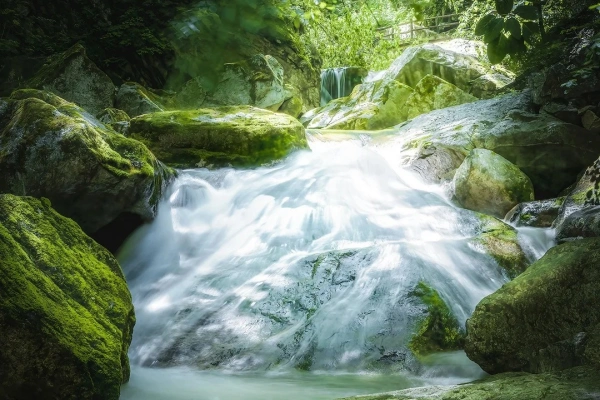Taiping National Forest Park
Historical Overview
The Qinling Mountains have been revered since the Zhou Dynasty (1046–256 BCE) as a sacred boundary between northern and southern China, inspiring poets like Li Bai and Du Fu. Established as a forest reserve in 1958, it became a national park in 2004 to protect its ecosystems and cultural relics. From the 2010s to the 2020s, the park expanded conservation efforts, including reforestation projects and wildlife corridors, while introducing eco-friendly tourism infrastructure. In 2023, it was recognized as a "National Ecological Civilization Education Base" for its role in promoting environmental awareness.
Structural Layout
The park’s terrain is divided into five distinct zones, each offering unique landscapes and activities. The Lower Valley Zone includes the entrance area with a visitor center, cultural square, and traditional Shaanxi-style architecture, as well as Jade Lake, a serene artificial lake surrounded by willow trees and pavilions, ideal for boating. The Middle Mountain Zone features the Waterfall Corridor, a 3-kilometer trail linking eight major waterfalls, including the 200-meter-high Hongyan Falls, and the Ancient Tree Grove, home to 1,000-year-old cypress and maple trees, with interpretive signs explaining their ecological significance. The Upper Peak Zone offers the Cloud Peak Observatory, a 2,800-meter-high viewpoint providing panoramic vistas of the Qinling range, and Temple Ruins, remnants of a Tang Dynasty (618–907 CE) Buddhist temple, including stone carvings and foundation stones.

Major Attractions
Hongyan Falls is the park’s tallest waterfall, plunging 200 meters into a mist-shrouded pool, best viewed from the suspension bridge below. Colorful Stone Beach is a geological wonder featuring smooth, multicolored stones shaped by millennia of water erosion, popular for photography. The Tang Dynasty Temple Site allows visitors to explore the ruins of a 7th-century monastery, including a partially preserved stupa and meditation caves. The Ecological Museum provides interactive exhibits on Qinling biodiversity, with live displays of local reptiles and amphibians. The Skywalk Bridge is a 150-meter-long glass bridge suspended 100 meters above a canyon, offering adrenaline-pumping views.
Suggested Itineraries
For a Half-Day Adventure lasting 3–4 hours, start at Jade Lake for a leisurely boat ride (30 mins). Then hike the Waterfall Corridor to Hongyan Falls (1.5 hours, moderate difficulty). Visit the Ecological Museum (30 mins) to learn about local wildlife. End at Colorful Stone Beach for a picnic (30 mins). A Full-Day Exploration of 6–7 hours can begin in the morning with Jade Lake, the Waterfall Corridor, and the Tang Dynasty Temple Site (2 hours). Have lunch with local noodles at a forest-view restaurant (1 hour). In the afternoon, hike to Cloud Peak Observatory (2 hours, steep trail) and cross the Skywalk Bridge (30 mins). Enjoy sunset views from the observatory before descending. A Family-Friendly Route of 4–5 hours can include Jade Lake playground and paddle boating (1 hour), a short hike to the first three waterfalls (1.5 hours, flat terrain), the Ecological Museum interactive zone (1 hour), and a Colorful Stone Beach scavenger hunt (1 hour).

Ticket Purchase
Tickets can be booked online via the official Taiping National Forest Park website or WeChat mini-program up to 3 days in advance. On-site tickets are available at the entrance, but lines are long during holidays. Standard Entry costs ¥65 for adults and ¥35 for students/seniors. An annual pass for unlimited visits is ¥200. Children under 1.2m, disabled visitors, and active-duty military personnel can enter for free.
Transportation
To reach the park by subway, take Line 2 to Weiqunan Station and then the park shuttle bus (¥15 round-trip, 40 mins). By bus, Route 921 from Xi’an’s South Bus Station goes directly to the park entrance (¥10, 1.5 hours). A direct taxi ride from downtown Xi’an costs ¥150–200 and takes 1 hour. There is a large parking lot at the entrance (¥10/day) with electric vehicle charging stations.
Best Time & Tips
To avoid crowds, it's best to visit outside peak hours of 10 AM–2 PM on weekends and holidays. Early morning (8–9 AM) or late afternoon (3–4 PM) are good times, and weekdays outside public holidays (e.g., avoid Golden Week in October) are the quietest. Spring (April–May) and autumn (September–October) offer mild temperatures and clear skies, while summer (June–August) is lush but rainy and winter (December–February) may have snow. Download the park’s AR map app for navigation. Wear sturdy shoes for hiking as trails can be slippery when wet. Bring snacks and water (refill stations available). Photography is allowed everywhere except inside the temple ruins, and prohibited items include drones, pets, and loudspeakers.

